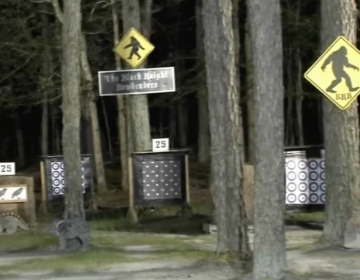Pine barrens documentary to be shown with live music at Princeton film festival
“Storytelling was once of enough importance in the Pine Barrens to give rise to a class of local Homers, some of whom did nothing at all but travel through the woods telling tales.”
This quote from John McPhee appears at the opening of David Scott Kessler’s film “The Pine Barrens,” and is a theme throughout as “Pineys”—people of the Pine Barrens — gather around bonfires to tell tales. As the flames reflect off their faces, we feel the heat of their disbelief or terror.
With lush cinematography and a symphony of sounds, Kessler takes us on a journey through the forested reserve that dominates the southern half of New Jersey. “The Pine Barrens” will be performed with live music by the Ruins of Friendship Orchestra at the Princeton Environmental Film Festival, Frist Campus Center Lecture Hall 302, Princeton University, on Saturday, April 1, 7 p.m.
The largest tract of undeveloped land between Maine and Florida, with 27 varieties of wild orchids, including Pink Lady’s Slipper, the Pine Barrens provides habitat to 43 threatened or endangered animals. In 1978, Congress passed legislation to designate 1.1 million acres as the Pinelands National Reserve, the nation’s first national reserve, thanks in part to the attention paid to the region by McPhee’s eponymous book. The Pine Barrens helps recharge the 17 trillion gallon Kirkwood-Cohansey aquifer containing some of the purest water in the United States.
The Pinelands have been in the news most recently because the 15-member Pinelands Commission, established in 1979 to serve as the guardians of preservation and responsible land use, voted to approve a controversial 22-mile pipeline through part of the environmentally sensitive lands.
In Kessler’s film, we watch fires, necessary for the replenishment of the pines, dance through the forest — if it weren’t for the fires, we’d be looking at oak or maple barrens. “Controlled burns help to remove non-native invasive growth and clear underbrush for pitch pines,” said Kessler from his studio in Philadelphia’s Old City. “The pine cones don’t even open until they reach about 180 degrees, so the pitch pines need fire.”
As mist rises from the water, a man in a safari hat and khakis paddles a kayak along the rusty waterways, narrating the adventure. The water is browned by iron deposits and tannins from leaf litter, and in turn spawns an array of plant and animal life. Ecologically, the Pine Barrens is anything but barren. Our narrator revels in the scents and the wind in the trees. Along the way we catch glimpses of Albert Music Hall, fungus, kids playing in water, raindrops and butterflies. There are conversations about getting lost in the woods at night, eating deer turd, finding the Jersey Devil. We spend a good amount of time surrounded by darkness, listening to the noises. We meet cranberry farmers, a decoy maker, a basket weaver and a jeweler who works with Pinelands “diamonds”—beautiful pieces of found glass in jewel tones that are polished to a high luster.
Forty-five minutes into this exploration of paradise, we are jolted by a soundtrack overlay of a Radio Times interview about the pipeline, which has been opposed by four preceding governors of New Jersey. Governor Christie appointed new members to the Commission known for their support of the pipeline. Their rationale: the pipeline will create jobs; natural gas is a more renewable form of energy than coal.
Cut to a section of graffiti: “NJ sucks.”
The narrator in the safari hat says “when you’re out here surrounded by reclaimed ruins, this place puts you in your proper place.”
The moon is full, moths are drawn to flame, humans imitate the sounds of the tree frog until the frog itself bellows back its quacking sound, a big bubble expanding and contracting under his jaw. The narrator takes us down a trail that has been widened by ATVs, destroying the plant life, destroying soil that could rejuvenate and heal the forest “but we never let it heal,” he said.
Back around the fire, there is conversation about how eugenics was born in the Pinelands. Despite inhospitable living conditions, Pineys lived off the land, collecting and selling what they hunted or fished. To discourage outsiders, Pineys told stories of violence, including stories of the Jersey Devil. But people who lived off the land were not generally well regarded. Pineys were considered, by some, to be the dregs of society: fugitives, poachers, moonshiners or deserting soldiers. In the early 20th century, “research” depicted them as inbred feeble-minded uneducated drunkards. These reports were used by Congress to pass the Immigration Act of 1924 that barred Eastern Europeans, Jews, Arabs and East Asians from entering the country, led to the sterilization of those deemed unfit and later influenced Nazi Germany.
Kessler, an artist, has known about the Pine Barrens since his childhood in Union. “I knew of it as a mysterious place with a devil, as part of weird New Jersey,” he says.
With the idea of using the Pines as a background for a graphic novel, he set out with his digital SLR and some of his friends who were musicians. In a former industrial town named Friendship, the Ruins of Friendship Orchestra was formed. They became familiar with the sounds of the Pines and, with harp, flute, banjo, viola, bass, trumpet, guitar, synthesizer and vocals, improvised.
As the battle over the pipeline continues—the Sierra Club plans to challenge the decision in court — Kessler will continue filming. “I’m an artist first and foremost and will continue to make art,” continues Kessler. “I became an advocate from spending so much time on this subject. I want to continue to make art, but if there’s a way I can contribute… we’ll see.”
_____________________________________________
The Artful Blogger is written by Ilene Dube and offers a look inside the art world of the greater Princeton area. Ilene Dube is an award-winning arts writer and editor, as well as an artist, curator and activist for the arts.
WHYY is your source for fact-based, in-depth journalism and information. As a nonprofit organization, we rely on financial support from readers like you. Please give today.





